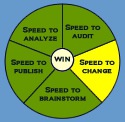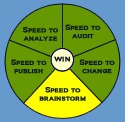During meetings with prospective clients, I tend to heavily emphasize the importance of speed to the success of their SEO initiatives. By the way, I’m not referring to page speed, although that also matters in certain situations. Instead, I’m referring to how quickly a client can move from idea to execution. This includes how fast they can audit, change, brainstorm, publish, analyze, and optimize their efforts. Many of you reading this post understand how digital marketing moves at light speed. In addition, many of you have probably run into situations where you provide great advice, a solid plan, only to be left staring at a production schedule that covers an entire year (or longer). And if matters get worse, that already long production schedule has to go through several committees for approval.
Yes, fun times. The dreaded committee review, which can drag out execution, while also watering down your efforts, is one of the points I brought up in my post about compromise and failure in SEO. I’ll touch on committees later in this post.
To me, you need to move fast, and at a high level, in order to succeed in today’s SEO environment. If you don’t, your efforts can creep along, your rankings will suffer, your site will underperform, and your boss will be unhappy (to say the least). Let’s explore speed for SEO in greater detail below.
The Impact of Speed on SEO

I wanted to begin by displaying a graph that documents the various ways that speed can impact your SEO efforts. The wedges represent Speed to Audit, Change, Brainstorm, Publish, and Analyze. I’ll cover each segment in detail below.
 Speed to Audit
Speed to Audit
If you’ve read previous posts of mine, then you know how powerful I believe SEO audits are. If you are a company that isn’t seeing strong performance from your organic search efforts, then pull the trigger and have a thorough audit completed. The faster you move to have one completed, the faster you’ll receive a thorough analysis of your current situation. And the faster you receive a remediation plan based on the audit, the faster you can fix the problems SEO-wise.
For example, do you have 2000 pages on your site, but only 48 indexed? Are 80% of your pages optimized the same exact way? Is your site throwing soft 404’s? Do you even know what that means? Is your navigation hidden from the search engine bots? Are you using AJAX extensively, but not ensuring it can be crawled? Did you recently migrate a site, only to leave thousands of URL’s in limbo? What happened to your rankings if you did? All of these problems can be revealed during an audit. It’s a great way to start any SEO initiative. And since I’m writing about speed, audits can be completed relatively quickly, depending on the size and complexity of the site at hand.
 Speed to Change
Speed to Change
Your Speed to Audit is important, but that will only get you so far. It’s how fast you implement changes based on the audit that will propel you to stronger rankings. This is where the rubber hits the road. If you have an audit completed, then a remediation plan is typically provided as part of the final presentation. The remediation plan contains all recommended changes in priority order, based on the audit results. The faster you move to implement changes, the faster those changes can take effect SEO-wise.
From an SEO perspective, there are often complex changes that can take a considerable amount of effort to implement. But, there are also changes that I consider low-hanging fruit that can be implemented relatively quickly. For example, optimizing core pieces of content, adding a more descriptive navigation, removing 302 redirects, ensuring you have sitemaps in place, fixing 404’s, etc. And the faster you can make these changes, the faster you can see an impact. The most successful clients I’ve had implemented changes within weeks of the remediation plan being presented. Depending on the current power of the site in question, I’ve seen some clients experience a positive impact in less than one month. Others take longer, as the “speed to results” completely depends on the site at hand.
 Speed to Brainstorm (and Approval)
Speed to Brainstorm (and Approval)
Taking a step back from audits and reactive changes for a second, let’s talk about brainstorming. When I help clients with content generation and linkbuilding, I often push to have a brainstorming session with key players from my client’s team. The faster you can set up that meeting, understand the goals of the team, gather the right people (including decision makers), and have your brainstorming session, the more chance you will have of experiencing success. Imagine having a three hour brainstorming session to determine possible ideas for new content, based on the collective knowledge of your team (including you, your client, and others from the company.) You might be able to leave that meeting with outstanding ideas, a rough production schedule, as well as approval. Compare that to several people throwing around random ideas via email for weeks, or worse, months. The opportunity cost of doing the latter can kill your potential success. Don’t let that happen. Move fast and get things approved.
 Speed to Publish
Speed to Publish
Similar to the Speed to Change bullet listed earlier, you need to execute and publish the ideas you brainstorm at a fast pace while maintaining high quality. That means translating ideas into applications, blog posts, infographics, whitepapers, videos, etc. Don’t let ideas sit. The longer you let them sit, the more opportunity you have to get them shot down. One of my mentors (a successful CEO I did a lot of work for earlier in my career) once told me, “Everybody has ideas. I want someone who successfully executes those ideas and generates results.” I think his quote relates extremely well to SEO. If you have a great idea, pitch that idea and get it approved. Do your research, develop your pitch, and then move fast. Some projects will take longer than others, so prioritize your efforts based on how quickly you can create the end-product and the potential impact it will have. And when you are ready to move, just move. Don’t hesitate.
For example, I once pitched an idea to a client for making changes that could open up a lot of content that was currently hidden from the search engines. Although they were a mid-sized company with an IT department of about 25 people, the Director of Marketing grabbed one person, her top developer, and made the changes quickly. She didn’t get everyone involved, since the content was technically on the site already (but was hidden). Three weeks later, their indexation jumped from 150K pages indexed to 475K. And it wasn’t thin content… the pages contained valuable information. A technical issue was inhibiting the bots from crawling the content, and she decided to take my advice and move at light speed to rectify the problem. It worked. You should try and move as fast as my client did. The upside is massive. By the way, you can read my post about opening up new content for SEO to learn how to avoid common pitfalls during implementation. There are some good lessons in that post.
 Speed to Analysis and Optimization
Speed to Analysis and Optimization
If you’ve moved quickly to audit, change, brainstorm, and publish, then you might feel like sitting at your desk with your feet up, drinking a frozen margarita, while listening to your favorite island music. Well, don’t get too comfortable. You’re only half way there. It’s critically important to ensure you are optimizing your SEO efforts based on performance. That means analyzing your natural search traffic based on various success metrics you have set up. i.e. conversion goals, event tracking, engagement, etc. The ongoing refinement of your SEO initiative is extremely important for improving your performance in natural search. Don’t just sit on high rankings, although that’s a good start. Close the loop and make sure it’s quality traffic that’s converting. Note, “conversion” can mean many things, and your analytics strategy might contain several macro and micro-conversions based on the site at hand.
You should analyze the keywords driving traffic, the landing pages from organic search, the links that your new content is building, etc. For example, imagine your analysis of a certain category of keywords revealed a high bounce rate, low engagement, and a .004% conversion rate. Why is that happening? Are those keywords not targeted? Are your landing pages from natural search not meeting visitor expectations content-wise? Is there a technical problem with the site? I’ve seen all of these potential issues be the problem. And without swift and accurate analysis, your client (or company) would be left staring at a Natural Search Visits Report that could be misleading, to say the least. Strong rankings and a surge in natural search traffic don’t tell the full story. Analytics can help you tie traffic and keywords to conversion. Performance, and not visits, will tell you if your efforts are successful.
Also, once you begin to analyze your SEO efforts, don’t keep the results to yourself. Move quickly to report on your findings. Set up meetings, have a voice, and make sure everyone understands the full impact of your efforts (traffic, conversion, engagement, linkbuilding, etc.) If you’ll need more changes implemented in the future, you’ll need others to know what’s happening. Speak up.
Some closing tips for moving fast in SEO:
- Annihilate committees. They are your nemesis. Destroy them. During my career of almost 16 years, I’ve seen committees consistently destroy or water down great ideas. You should streamline the decision making process at your organization. Committees will not help you or your team succeed. Avoid them at all costs.
- Wear your results until action is taken. If you see poor performance and lack of action, start writing down some of your key metrics on a nametag and slap into on your chest for everyone to see. I will guarantee that people ask you questions about what the numbers mean. That’s a great opportunity to tell people what the problems are, along with how it’s hurting the company’s performance. I’ve used this tactic at several organizations. It works.
- Have an SEO audit completed. Audits provide the biggest bang for your SEO buck. The faster you can move to understand the problems your site has, the faster you can move to make changes. The faster you can make changes, the faster you can increase your natural search power. It’s that straightforward…
- Perform a competitive analysis. There’s nothing that gets people moving like seeing your competition winning. Show key players at your organization how the competition is winning in Natural Search. You can learn a lot from a competitive analysis, and I haven’t met one CEO that doesn’t want to beat the competition. And there’s nothing like seeing a CEO run down the halls of his company with a competitive analysis in his hands. 🙂
Summary: Speed to Results
SEO is unique. It takes time to build strength, it takes time to see results (usually), but it’s also residual. Results can last for a long time, and at a very low cost (as compared to other channels). In my experience, I’ve seen too many efforts go nowhere, based solely on companies not taking action. In today’s digital marketing environment, speed isn’t just an advantage. It’s a necessity. So don’t hesitate, take your top priorities in SEO right now, and get moving. Wear your metrics on your chest, have an audit scheduled, brainstorm better ideas, quickly pitch those ideas, and get approval.
To revisit the quote I mentioned earlier, don’t simply be the person with great ideas… be the person with great ideas that can actually execute them. Then you’ll win.




